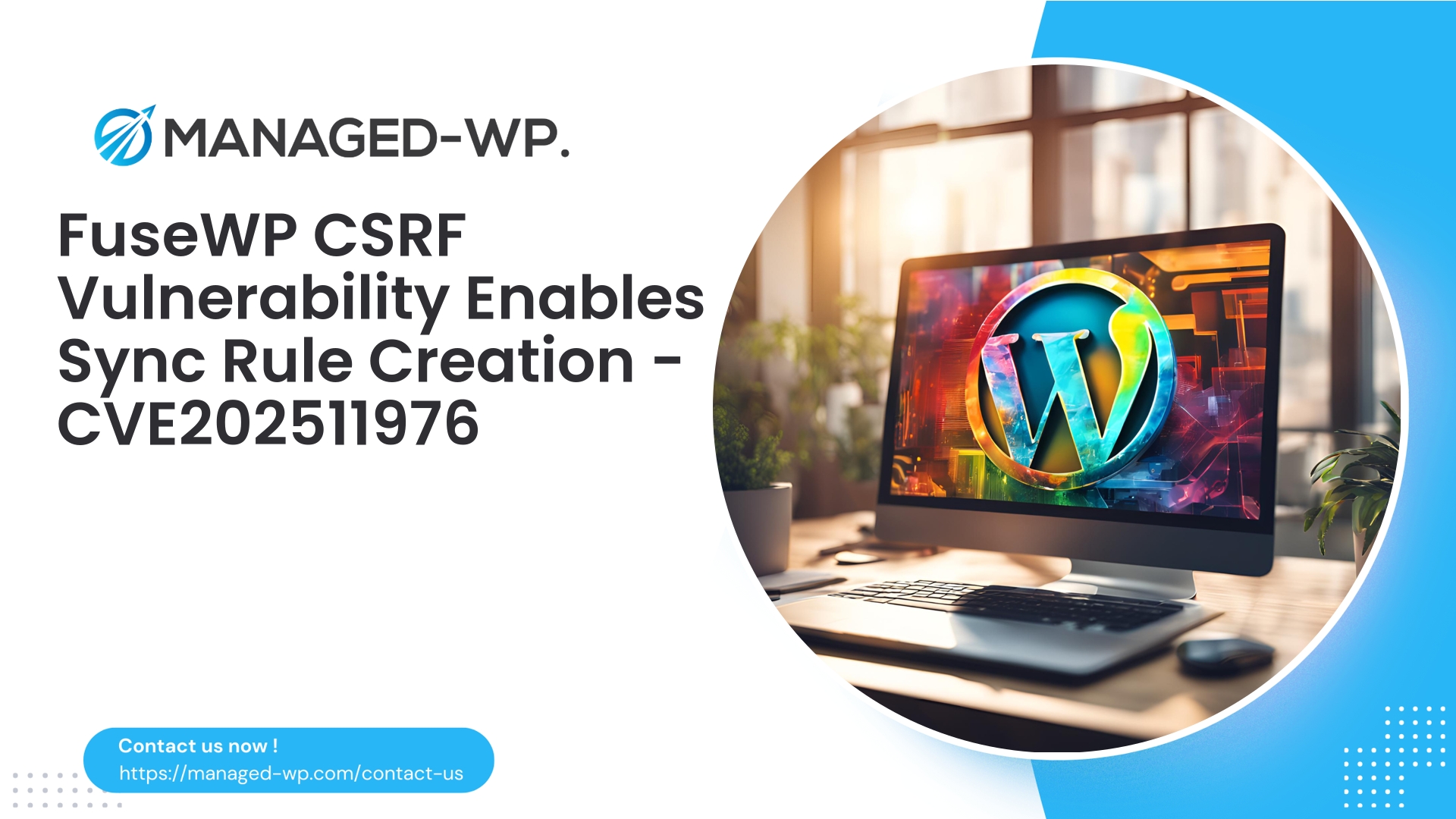| Plugin Name | Listeo |
|---|---|
| Type of Vulnerability | Stored XSS |
| CVE Number | CVE-2025-8413 |
| Urgency | Low |
| CVE Publish Date | 2025-10-25 |
| Source URL | CVE-2025-8413 |
Listeo Theme <= 2.0.8 — Authenticated (Contributor+) Stored XSS via soundcloud Shortcode — Critical Insights for Site Owners
Author: Managed-WP Security Experts
Overview: A Stored Cross-Site Scripting (XSS) vulnerability identified in the Listeo WordPress theme (versions <= 2.0.8, patched in 2.0.9) allows authenticated users with Contributor-level privileges or higher to inject malicious JavaScript via the soundcloud shortcode. This detailed briefing from Managed-WP walks through the threat, exploitation pathways, detection measures, remediation guidance, and actionable mitigations. We also explain how deploying a managed Web Application Firewall (WAF) can shield your site ahead of updates.
Essential Facts
- Affected product: Listeo WordPress theme
- Vulnerable versions: <= 2.0.8
- Patched in: 2.0.9
- Vulnerability type: Stored Cross-Site Scripting (Stored XSS)
- Required privilege: Contributor (authenticated user) or higher
- CVE Identifier: CVE-2025-8413
- Risk classification: Medium (CVSS 6.5); low patch urgency but potential impact is context-dependent, based on how front-end submissions and content rendering are configured.
Why This Vulnerability Demands Your Attention
Stored XSS vulnerabilities are perilous because malicious scripts persist in your site’s content and run every time a visitor accesses the infected page. While the threat specifically requires an authenticated user with Contributor or higher privileges, many listing or marketplace themes—like Listeo—offer front-end submission capabilities, often unintentionally increasing risk by potentially exposing these injection points to less trusted users.
An attacker leveraging this flaw can:
- Hijack session cookies or authentication tokens (if not properly protected)
- Perform unauthorized actions on behalf of legitimate users (mimicking CSRF attacks)
- Inject deceptive content or phishing interfaces to compromise visitors
- Redirect users to malicious external sites or load harmful third-party scripts
- Embed crypto-miners, trackers, or unsolicited advertisements covertly
The persistence of the payload means multiple visitors can be affected, complicating incident containment and remediation.
How the Vulnerability Operates: Technical Overview
The flaw exists in the processing of the soundcloud shortcode. These shortcodes generate HTML dynamically on the server and are embedded within posts, listings, or other content. The vulnerable code permits certain parameters or content passed to the soundcloud shortcode to be saved into the database without adequate sanitization or escaping upon rendering.
Key considerations:
- Attackers must be authenticated Contributors or have at least equivalent privileges (including front-end submitters).
- Malicious values can be embedded within shortcode attributes (such as malformed URLs or JavaScript events).
- The theme stores this input in the database (post content, term metadata, or listing metadata).
- When a visitor loads the affected page, the unsanitized data is output, executing harmful client-side scripts.
Note: For safety and ethical reasons, this advisory excludes exact exploit payloads to prevent misuse. Our focus remains on detection, remediation, and effective mitigation strategies.
Common Exploitation Scenarios
-
Front-end listing submissions:
- Sites using Listeo often allow users to post listings that include media embeds like SoundCloud. Attackers with contributor access can inject malicious shortcodes via these listings, which then activate when viewed.
-
Comments or reviews supporting shortcodes:
- If the theme or plugins enable shortcodes in reviews or comments and contributors are allowed to add them, malicious scripts can persist and affect other site visitors.
-
Compromised low-privilege accounts:
- Through credential stuffing or weak passwords, attackers may gain Contributor access and weaponize the shortcode injection to pivot attacks.
-
Dashboard content editors with inadequate vetting:
- Improper content approval processes can allow unsafe shortcode data to be published through drafts or direct edits.
How to Determine If Your Site Is At Risk
-
Verify theme version:
- Confirm your active Listeo version in Appearance → Themes or by inspecting theme files. Versions ≤ 2.0.8 require urgent updating.
-
Locate shortcode usage:
- Review theme files and templates for the soundcloud shortcode handler; check areas that output listing descriptions or post content.
-
Search database for indicators:
- Run read-only queries searching for “
[soundcloud” or suspicious<script>,on*attributes in post_content, postmeta, or termmeta tables. - Example:
SELECT ID, post_title FROM wp_posts WHERE post_content LIKE '%[soundcloud%'; - Also investigate comments or reviews tables if applicable.
- Run read-only queries searching for “
-
Audit user accounts:
- Identify any unexpected Contributor accounts and evaluate account creation history relative to suspicious content.
-
Analyze server access logs:
- Inspect POST requests targeting front-end submission endpoints originating from potentially malicious IP addresses.
-
Observe browser behavior:
- Look for user reports detailing pop-ups, redirects, or anomalies originating from pages with suspected shortcode injections.
Urgent Mitigation Steps Before Applying Patches
The following measures can reduce risk immediately while you plan for a full patch and clean-up:
-
Apply official patch:
- Upgrade Listeo to version 2.0.9 or newer as the primary, definitive resolution.
-
Limit contributor capabilities:
- Temporarily restrict or disable front-end content submission for Contributors until patched.
- Suspend or remove any suspicious Contributor accounts.
-
Disable processing of soundcloud shortcode:
- Remove or disable the shortcode handler globally via
remove_shortcode('soundcloud'). - Alternatively, strip shortcodes from user-submitted content before saving, to prevent execution.
- Test these steps on a staging environment to ensure no disruption.
- Remove or disable the shortcode handler globally via
-
Sanitize inputs rigorously:
- Implement
wp_kses()with strict allowed tag sets for front-end submissions. - Validate URLs explicitly for fields that require them using
filter_var($url, FILTER_VALIDATE_URL).
- Implement
-
Harden output escaping:
- Ensure theme templates use appropriate escaping functions (
esc_url(),esc_attr(),esc_html()) for all dynamic output. - Add additional escaping layers around shortcode renderings where possible.
- Ensure theme templates use appropriate escaping functions (
-
Enforce browser-level protections:
- Deploy strict Content-Security-Policy (CSP) headers to restrict allowable script execution sources.
- Set cookies with
HttpOnlyandSecureflags to limit session hijacking.
-
Deploy a Web Application Firewall (WAF):
- Use a properly configured WAF to detect and block shortcode injection attempts and suspicious payloads.
- Managed-WP can provide virtual patches that proactively block malicious requests related to the soundcloud shortcode.
Incident Response: Steps for Cleanup After Compromise
If you have already been compromised, follow this structured approach:
-
Isolate infected content:
- Put affected posts or listings into draft or private mode during cleanup.
-
Remove malicious shortcode data:
- Manually sanitize or remove offending shortcodes from content.
- For mass cleanups, perform careful database search-and-replace after full backups.
- Avoid blind bulk queries; ensure backups precede any changes.
-
Rotate credentials:
- Force password resets for recently created or suspicious user accounts.
- Regenerate admin API keys, application passwords, and any exposed external keys.
-
Audit user and activity logs:
- Trace when and which accounts introduced the malicious content.
-
Conduct malware scans:
- Use reliable scanning tools to check files and databases for webshells or injected backdoors.
-
Terminate suspicious user sessions:
- Log out all users suspected of involvement and require fresh login credentials.
-
Notify users if needed:
- Follow regulatory requirements if user PII or credentials were potentially exposed.
-
Restore backups if necessary:
- If cleanup proves difficult or the site isn’t stable, revert to a clean snapshot taken before the compromise.
Hardening Your Site Against Future Attacks
-
Apply the Principle of Least Privilege:
- Ensure users only have the minimum required permissions. Review Contributor roles and any custom permissions related to front-end submissions.
-
Enforce Strict Content Sanitization:
- Utilize WordPress core functions like
wp_kses_post()for sanitizing untrusted inputs. - Validate inputs rigorously, especially those intended to be URLs or embed codes.
- Utilize WordPress core functions like
-
Strengthen Template Security:
- Audit theme and shortcode handler code for proper escaping practices to prevent injection.
-
Keep Dependencies Updated:
- Regularly update themes, plugins, and WordPress core after testing in staging environments.
-
Maintain Effective Monitoring and Logging:
- Track content submissions, edits, IP addresses, and user agents for better incident response.
-
Implement Security Headers:
- Use restrictive Content-Security-Policy, X-Frame-Options, X-Content-Type-Options, and HSTS headers.
-
Run Automated Scanning Regularly:
- Schedule periodic scans focused on detecting XSS payloads and suspicious script tags.
How Managed-WP’s Web Application Firewall and Virtual Patching Protect You
Leveraging a modern Web Application Firewall (WAF) offers a critical security layer that filters attack traffic before it reaches your site. Virtual patching allows immediate mitigation of vulnerabilities without waiting for code changes.
Recommended WAF controls for this vulnerability include:
- Blocking requests attempting to inject suspicious parameters into the soundcloud shortcode from untrusted users.
- Detecting and sanitizing script-like or event-handler attributes embedded in shortcode parameters.
- Enforcing source-based rules allowing shortcode usage only by trusted roles or IP ranges.
- Rate-limiting or alerting for repeated potentially malicious submission attempts.
Illustrative WAF logic (pseudocode):
- If a POST request to a front-end content submission endpoint contains “[soundcloud” plus suspicious script keywords (“<script”, “javascript:”, “onerror=”, “onload=”), then block and log.
- If shortcode parameters contain invalid URLs or script content, sanitize or reject the request.
Note: Specific rule details are proprietary to avoid attacker circumvention. Managed-WP’s expert team provides tailored virtual patches that can neutralize this vulnerability at the edge, protecting your site immediately.
Recommended Temporary Code Snippets for Mitigation
These safe code examples can be added to your functions.php or a site-specific plugin to reduce risk prior to patching. They do not include exploit code but help prevent shortcode execution and validate inputs.
1) Disable the soundcloud shortcode processing temporarily:
// Disable soundcloud shortcode globally until patched
add_action('init', function() {
if (shortcode_exists('soundcloud')) {
remove_shortcode('soundcloud');
}
}, 20);
2) Strip shortcodes from user-submitted listings before saving:
// Replace 'listing' with your custom post type slug
add_filter('content_save_pre', function($content) {
if (isset($_POST['post_type']) && $_POST['post_type'] === 'listing') {
// Remove shortcodes for non-privileged users
if (!current_user_can('edit_others_posts')) {
$content = strip_shortcodes($content);
}
}
return $content;
});
3) Validate SoundCloud URLs rigorously:
function validate_soundcloud_url($url) {
if (!filter_var($url, FILTER_VALIDATE_URL)) {
return false;
}
$host = parse_url($url, PHP_URL_HOST);
return (strpos($host, 'soundcloud.com') !== false);
}
Important: Always test these snippets on a staging environment before deploying to production. These are temporary mitigations and should be replaced with official patches and cleanups.
Post-Patch Verification and Detection
- Re-examine database content: Verify all affected content is clean and no injection strings remain.
- Inspect file system: Confirm absence of webshells or unauthorized files.
- Monitor logs: Watch for unusual or blocked submission attempts via WAF and server logs.
- Test output escaping: Ensure dynamic content renders safely without unescaped HTML or scripts.
When to Call in Professional Incident Response
Engage specialized security professionals if you observe:
- Signs of extensive compromise such as unknown administrators, core file modifications, or webshells.
- Evidence of data leakage involving sensitive user information.
- Repeated infections despite repeated cleanup attempts.
Managed-WP offers expert incident response services to guide detailed forensic investigation, remediation, and future-proofing your site.
Introducing Managed-WP’s Basic Managed Protection Plan – Complimentary for Your Security
While preparing to patch or clean your site, immediate protection is essential. Managed-WP provides a Basic (Free) Managed Protection Plan offering:
- Custom firewall rules tailored to WordPress security threats
- Advanced Web Application Firewall (WAF) blocking injection and malicious shortcode attempts
- Automated malware scanning of files and database
- No bandwidth limits and streamlined onboarding for rapid activation
Apply for the Basic plan here: https://my.wp-firewall.com/buy/wp-firewall-free-plan/
For enhanced features like automated malware removal, customized IP blacklisting, monthly reporting, and virtual patching, paid tiers are available.
Your Critical To-Do List: A Summary Checklist
- Confirm your Listeo theme version and update immediately to 2.0.9 or newer.
- Temporarily restrict or disable front-end submissions from untrusted roles.
- Search and sanitize database content containing soundcloud shortcodes or suspicious script tags.
- Temporarily disable soundcloud shortcode processing if you cannot update immediately.
- Rotate all relevant credentials and audit user account activity.
- Deploy a robust WAF or enable virtual patching to preempt active injection attempts.
- Implement rigorous output escaping and input validation as a permanent safeguard.
Final Thoughts from Managed-WP Security Specialists
This Stored XSS vulnerability highlights the growing complexity and risk vectors in modern WordPress environments. Themes with front-end submission features offer rich user experiences but can inadvertently increase attack surfaces if strict sanitization is lacking. Fortunately, a combination of timely patching, content auditing, role hardening, security headers, and managed WAF protection can effectively manage and neutralize these risks.
Our security team stands ready to assist in exposure assessments and rapid deployment of protective measures. If you’re not yet protected, our Basic Managed Protection plan provides an immediate defense layer, enabling safer updates and remediation: https://my.wp-firewall.com/buy/wp-firewall-free-plan/
Stay vigilant. Keep your WordPress ecosystem updated, and always adopt multi-layered security strategies for resilient site operations.



















